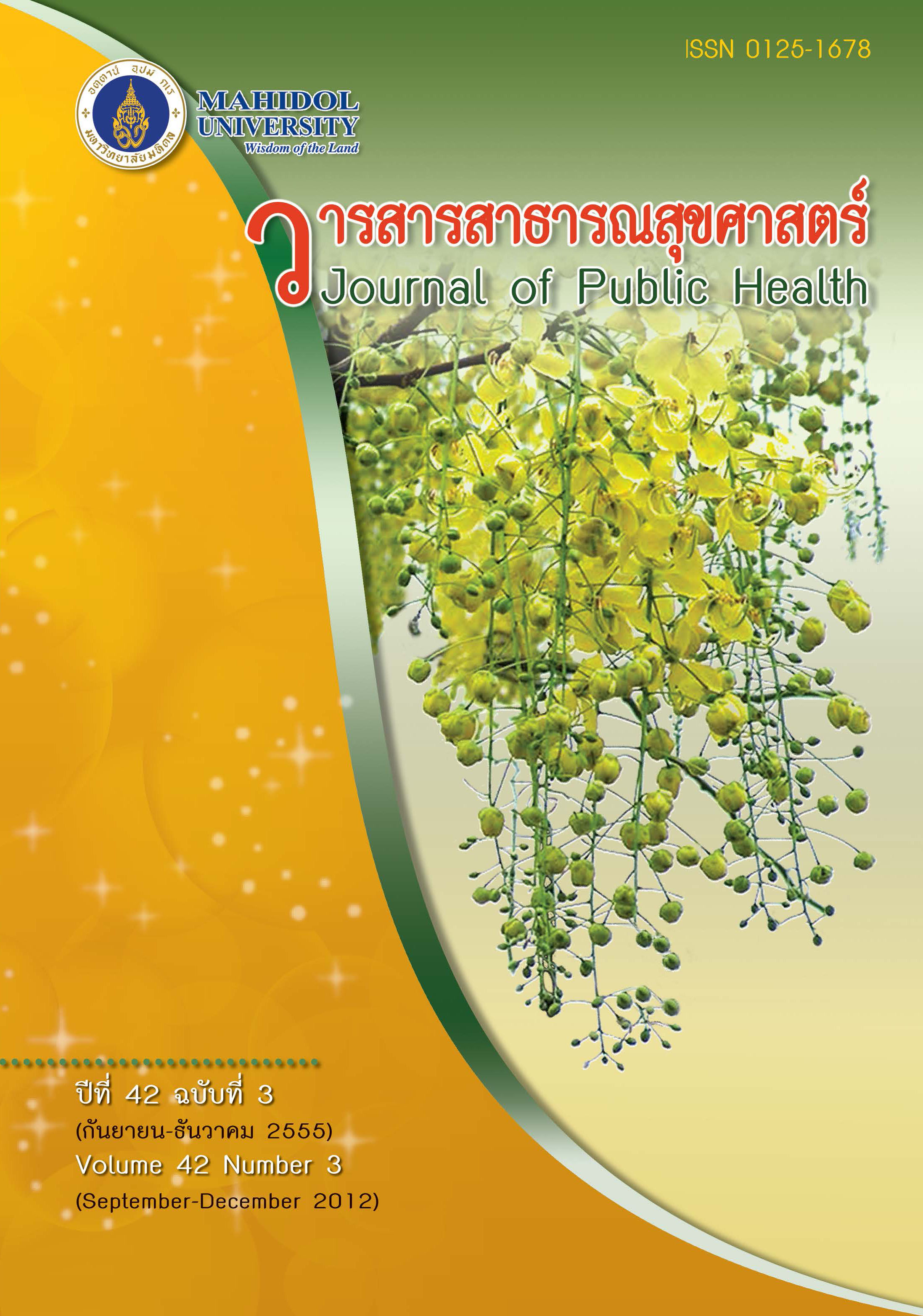การตรวจหาแบคทีเรียย่อยไขมันจากตัวอย่างสิ่งแวดล้อม
Keywords:
แบคทีเรียย่อยไขมัน, น้ำเสีย, lipolytic bacteria, wastewaterAbstract
บทคัดย่อ
การศึกษานี้ มีจุดมุ่งหมายเพื่อทดสอบประสิทธิภาพในการย่อยไขมันของแบคทีเรียที่แยกได้จาก น้ำเสียจากถังดักไขมัน (4 ตัวอย่าง) น้ำหมักชีวภาพ (2 ตัวอย่าง) น้ำจากคลองรวบรวมน้ำเสีย(2 ตัวอย่าง) และตะกอนดินป่าชายเลน (3 ตัวอย่าง) โดยนำตัวอย่าง มาเพาะเลี้ยงในอาหาร screening medium บ่มที่ อุณหภูมิห้อง เป็นเวลา 48 ชั่วโมง แล้วย้ายไปยัง อาหาร tributyrin agar เพื่อคัดเลือกแบคทีเรียที่มี คุณสมบัติที่ต้องการ พบว่าแยกแบคทีเรียที่ย่อยไขมัน ได้รวม 39 ไอโซเลท โดยผ่านขั้นการตรวจคัดเลือก 13 ไอโซเลท ซึ่งแยกได้ จากน้ำเสียถังดักไขมันน้ำหมักชีวภาพ น้ำเสียจากคลอง และตะกอนดินป่าชายเลน จำนวน 7 4 1 และ 1 ไอโซเลท ตามลำดับ เพื่อนำไปทดสอบประสิทธิภาพการย่อยไขมัน พบว่า แบคทีเรียที่แยกจากถังดักไขมัน T3/2 สามารถย่อยน้ำเสียไขมันในสังเคราะห์ได้ดีกว่าแบคทีเรียที่แยกได้ จากแหล่งอื่นคือสามารถย่อยไขมันได้ร้อยละ 52.0 อัตราการย่อยไขมัน 0.025 มิลลิลิตรต่อวันในช่วง เวลาทดสอบ 21 วัน ที่อุณหภูมิห้อง เมื่อติดตาม การเปลี่ยนแปลงของน้ำเสียไขมันสังเคราะห์ที่ย่อย ด้วยแบคทีเรียที่แยกได้ พบว่าน้ำเสียไขมันสังเคราะห์ เริ่มมีการเปลี่ยนแปลงสภาพตั้งแต่วันแรกจนถึงวันที่ 11 ของการทดสอบ โดยน้ำใสขึ้น มีการตกตะกอน และความหนาของชั้นไขมันลดลง แบคทีเรียที่แยกได้ จากการศึกษานี้สามารถย่อยสลายไขมันได้ดี การ เพาะเลี้ยงง่าย ดังนั้นจึงเหมาะกับการนำไปพัฒนา เพื่อใช้ในการบำบัดน้ำเสียที่มีไขมันได้ โดยประหยัด ค่าใช้จ่ายและปลอดภัยต่อสิ่งแวดล้อม
คำสำคัญ: แบคทีเรียย่อยไขมัน; น้ำเสีย
ABSTRACT
The aim of this study was to determine the lipid hydrolysis efficiency of the bacteria isolated from wastewater from grease traps (4 samples), bio-fermented water (2 samples), water from wastewater collecting canal (2 samples) and sediments of mangrove (3 samples). The samples were cultured in a screening medium at room temperature for 48 hours, then transferred to tributyrin agar for selecting the lipolytic bacteria isolates. A total of 39 lipolytic isolates were found. Only 13 selected isolates from the wastewater from grease traps, bio-fermented water, water from wastewater collecting canal and sediments of mangrove; 7, 4, 1 and 1 isolates, respectively, were selected for testing the lipid hydrolysis efficiency. The T3/2 isolated from grease traps, can decompose the synthetic lipid wastewater more than bacteria isolated from others. It has 52 percentage of lipid digestion with 0.025 mL/day of the average rate of lipid hydrolysis within 21 days at room temperature. Following the degradation of synthetic lipid wastewater by isolated bacteria, physiological changes were observed since the first day until the 11th day of the testing. The synthetic lipid wastewater was clear, and precipitation and the thickness of lipid layer decreased. The lipolytic bacteria from this study can hydrolyze lipid well and can grow easily in a basic medium. Thus, it is appropriate to be developed and used in treatment of lipid containing wastewater with cost-effective and environmental friendly.
Key words: lipolytic bacteria; wastewater
Downloads
Issue
Section
License
Creative Commons License CC-BY-ND


